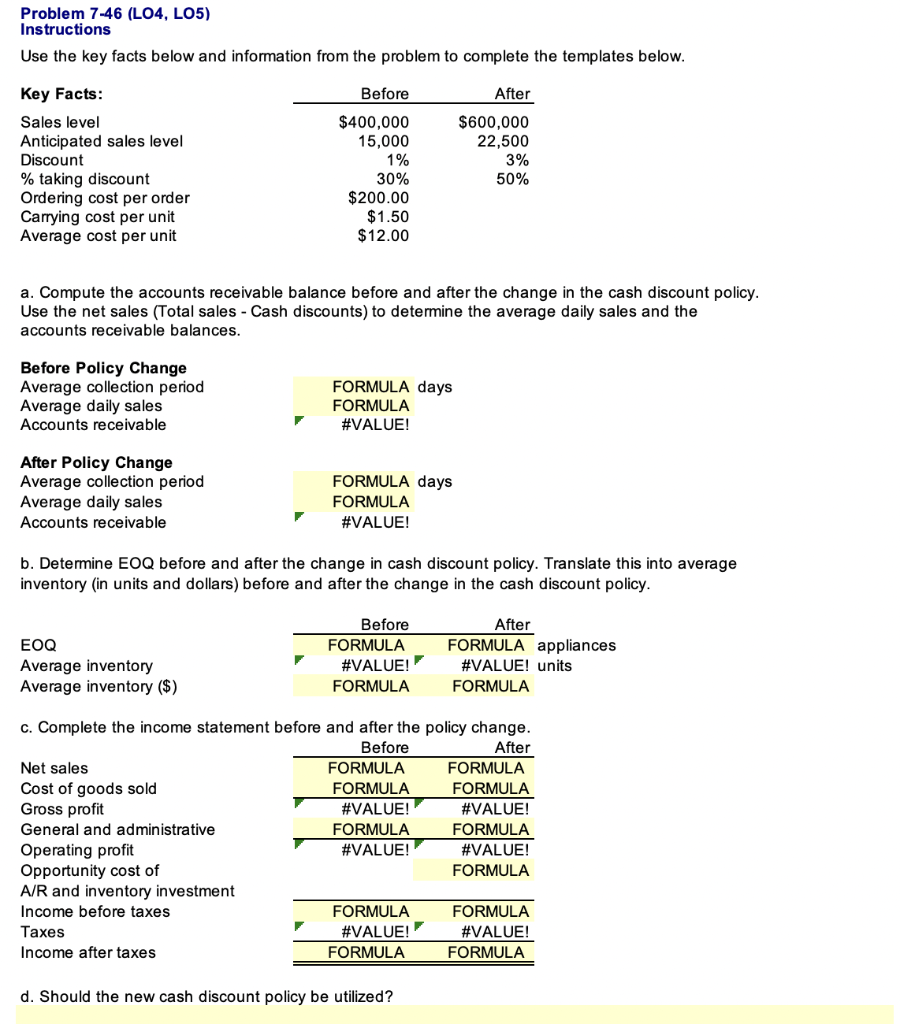

Foundations of Financial Management Block, Hirt, Danielson and Short: Eleventh Canadian Edition Problem 7-46 (LO4, LO5) Analyze receivables and inventory policy Student Name: Course Name: Student ID: Course Number: Logan Distributing Company sells fans and heaters to hardware stores throughout the vest. Joe Logan, the president of the company, is thinking about changing the credit policies offered by the firm to attract customers away from competitors. The current policy calls for a 1/10, net 30, and the new policy would call for a 3/10, net 50. Currently, 30 percent of Logan customers are taking the discount, and it is anticipated that the number would go up to 50 percent with the new discount policy. It is further anticipated that annual sales would increase from a level of $400,000 to $600,000 as a result of the change in the cash discount policy. The increased sales would also affect the inventory level carried by Logan. The average inventory carried by Logan is based on a determination of an EOQ. Assume unit sales of fans and heaters will increase from 15,000 to 22,500 units. The ordering cost for each order is $200 and the carrying cost per unit is $1.50 (these values will not change with the discount). Each unit in inventory has an average cost of $12.00. Cost of goods sold is equal to 65 percent of net sales, general and administrative expenses are equal to 15 percent of net sales, and interest payments of 14 percent will be necessary only for the increase in the accounts receivable and inventory balances. Taxes will equal 40 percent of before-tax income. a. Compute the accounts receivable balance before and after the change in the cash discount policy. Use the net sales (Total sales - Cash discounts) to determine the average daily sales and the accounts receivable balances. b. Determine EOQ before and after the change in cash discount policy. Translate this into average inventory (in units and dollars) before and after the change in the cash discount policy. c. Complete the income statement before and after the policy change. d. Should the new cash discount policy be utilized? Briefly comment. Problem 7-46 (L04, LO5) Instructions Use the key facts below and information from the problem to complete the templates below. Before After Key Facts: Sales level Anticipated sales level Discount % taking discount Ordering cost per order Carrying cost per unit Average cost per unit $400,000 15,000 1% 30% $200.00 $1.50 $12.00 $600,000 22,500 3% 50% a. Compute the accounts receivable balance before and after the change in the cash discount policy. Use the net sales (Total sales - Cash discounts) to determine the average daily sales and the accounts receivable balances. Before Policy Change Average collection period Average daily sales Accounts receivable FORMULA days FORMULA #VALUE! After Policy Change Average collection period Average daily sales Accounts receivable FORMULA days FORMULA #VALUE! b. Determine EOQ before and after the change in cash discount policy. Translate this into average inventory (in units and dollars) before and after the change in the cash discount policy. Before FORMULA EOQ Average inventory Average inventory ($) After FORMULA appliances #VALUE! units FORMULA #VALUE! FORMULA c. Complete the income statement before and after the policy change. Before After Net sales FORMULA FORMULA Cost of goods sold FORMULA FORMULA Gross profit #VALUE! #VALUE! General and administrative FORMULA FORMULA Operating profit #VALUE! #VALUE! Opportunity cost of FORMULA A/R and inventory investment Income before taxes FORMULA FORMULA Taxes #VALUE! #VALUE! Income after taxes FORMULA FORMULA d. Should the new cash discount policy be utilized? Foundations of Financial Management Block, Hirt, Danielson and Short: Eleventh Canadian Edition Problem 7-46 (LO4, LO5) Analyze receivables and inventory policy Student Name: Course Name: Student ID: Course Number: Logan Distributing Company sells fans and heaters to hardware stores throughout the vest. Joe Logan, the president of the company, is thinking about changing the credit policies offered by the firm to attract customers away from competitors. The current policy calls for a 1/10, net 30, and the new policy would call for a 3/10, net 50. Currently, 30 percent of Logan customers are taking the discount, and it is anticipated that the number would go up to 50 percent with the new discount policy. It is further anticipated that annual sales would increase from a level of $400,000 to $600,000 as a result of the change in the cash discount policy. The increased sales would also affect the inventory level carried by Logan. The average inventory carried by Logan is based on a determination of an EOQ. Assume unit sales of fans and heaters will increase from 15,000 to 22,500 units. The ordering cost for each order is $200 and the carrying cost per unit is $1.50 (these values will not change with the discount). Each unit in inventory has an average cost of $12.00. Cost of goods sold is equal to 65 percent of net sales, general and administrative expenses are equal to 15 percent of net sales, and interest payments of 14 percent will be necessary only for the increase in the accounts receivable and inventory balances. Taxes will equal 40 percent of before-tax income. a. Compute the accounts receivable balance before and after the change in the cash discount policy. Use the net sales (Total sales - Cash discounts) to determine the average daily sales and the accounts receivable balances. b. Determine EOQ before and after the change in cash discount policy. Translate this into average inventory (in units and dollars) before and after the change in the cash discount policy. c. Complete the income statement before and after the policy change. d. Should the new cash discount policy be utilized? Briefly comment. Problem 7-46 (L04, LO5) Instructions Use the key facts below and information from the problem to complete the templates below. Before After Key Facts: Sales level Anticipated sales level Discount % taking discount Ordering cost per order Carrying cost per unit Average cost per unit $400,000 15,000 1% 30% $200.00 $1.50 $12.00 $600,000 22,500 3% 50% a. Compute the accounts receivable balance before and after the change in the cash discount policy. Use the net sales (Total sales - Cash discounts) to determine the average daily sales and the accounts receivable balances. Before Policy Change Average collection period Average daily sales Accounts receivable FORMULA days FORMULA #VALUE! After Policy Change Average collection period Average daily sales Accounts receivable FORMULA days FORMULA #VALUE! b. Determine EOQ before and after the change in cash discount policy. Translate this into average inventory (in units and dollars) before and after the change in the cash discount policy. Before FORMULA EOQ Average inventory Average inventory ($) After FORMULA appliances #VALUE! units FORMULA #VALUE! FORMULA c. Complete the income statement before and after the policy change. Before After Net sales FORMULA FORMULA Cost of goods sold FORMULA FORMULA Gross profit #VALUE! #VALUE! General and administrative FORMULA FORMULA Operating profit #VALUE! #VALUE! Opportunity cost of FORMULA A/R and inventory investment Income before taxes FORMULA FORMULA Taxes #VALUE! #VALUE! Income after taxes FORMULA FORMULA d. Should the new cash discount policy be utilized








